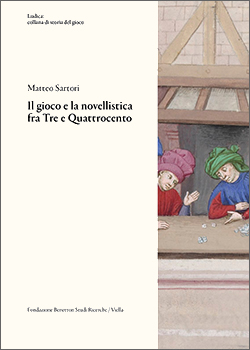
Il gioco e la novellistica fra Tre e Quattrocento
[Games and the novella in the 14th and 15th centuries]
by Matteo Sartori
Fondazione Benetton Studi Ricerche-Viella
Treviso-Rome 2021
XII-160 pages
37 illustrations in colour and 2 in black and white
cover price 25 euros
ISBN 978-88-3313-778-0
(Ludica, 16)
The later centuries of the Middle Ages saw the rise in popularity of the novella, a short tale offering a highly realistic account of historical or imagined events and firmly rooted in the milieu of the time. Novellas contain numerous incidental descriptions of pastimes, games and other ludic activities and this study uses them to analyze how the underlying logic of ludicity changed during the 1300s and 1400s.
The research is organized by theme: starting from the meaning attributed to the concepts of idleness and time, the novella itself is interpreted as a sort of literary game, focusing attention on open-air pursuits such as jousting, tournaments, hunting and fencing, board games such as dice, backgammon, chess and gambling, and finally festivities, music and dancing.
The analysis of these ludic phenomena sets out to reveal not only their specific features but also their shared characteristics and sheds light on the changes that took place over the two centuries.
During the period of Renaissance humanism the authors of novellas tended to feature more spectacular games, to recall the customs of classical civilization and to emphasize distinctions in social ranking.
Contents
Alessandra Rizzi, Introduzione
I. L’ozio e il tempo: due concetti chiave nella ludicità tre-quattrocentesca
1. L’importanza, il significato e la presenza dell’ozio
2. Il Quattrocento e il recupero dell’ozio: tra condanna ed elogio
3. Il recupero dell’ozio nel Quattrocento: un segno del tempo che cambia
4. L’assenza del tempo libero e l’importanza del tempo
5. L’interpretazione trecentesca del tempo
6. L’importanza del denaro e del tempo: una poesia del Soldanieri
7. Il Sercambi e la concezione del tempo nel Quattrocento
8. Qualche riflessione conclusiva
II. Il gioco del novellare
1. Il contesto narrativo trecentesco
2. Il fine narrativo nelle novelle del Quattrocento
3. Il soggetto letterario: spinta a scrivere od ostacolo?
4. Le novelle: un’eredità latina
5. La logica letteraria fra Tre e Quattrocento si modifica
III. Le giostre, i tornei, i bigordi, la scherma e la caccia
1. La giostra e il torneo: due giochi simbolo del medioevo
2. L’armeggiare è affare da nobili
3. Un’abilità presa in seria considerazione e un atto d’amore
4. L’armeggiare come espressione del potere e della magnificenza di un’autorità
5. La caccia
IV. I giochi da tavolo: i dadi, le tavole, gli scacchi e la figura del barattiere
1. “Mettitori di malvagi dadi” e la “maligna radice”: una consuetudine ludica trecentesca
2. I dadi nel secolo XV
3.“Zara a chi tocca”: una metafora della vita
4. Chi gioca a taule e a scachi nelle novelle del Trecento
5. L’assenza del gioco nelle novelle quattrocentesche
6. Una possibile spiegazione dell’assenza di scacchi e dadi, e anche delle carte
7. La baratteria e i barattieri: dimensioni e figure sociali evanescenti
V. La festa, la danza e la musica
1. La festa: una premessa metodologica
2. Le feste religiose
3. Le feste nuziali nel Trecento
4. … e nel Quattrocento
5. Una questione lessicale
6. Dall’allegria alla solennità
7. La festa e due pratiche ludiche connesse: la musica e la danza
8.Gli strumenti musicali: una questione di nobiltà
9. L’abilità musicale nel Quattrocento
10. La danza: una metafora sessuale quattrocentesca
Conclusioni; Bibliografia; Fonti primarie; Fonti secondarie; Nota sull’apparato iconografico; Elenco delle illustrazioni; Indice dei nomi e dei luoghi.
Matteo Sartori was born in Vicenza in 1988 and graduated in History at Ca’ Foscari University, Venice and at the Universidad Nacional de Tres de Febrero in Buenos Aires, with a dissertation on games and novellas in the 14th and 15th centuries. In 2014 his dissertation was awarded the Gaetano Cozzi Scholarships by the Fondazione Benetton Studi Ricerche. He is currently studying for a Ph.D in History at the Universidad de Concepción (Chile). His main research interests are the history of ideas in the fields of scientific and environmental studies, with a specific focus on medicinal plants that are native to South America.
